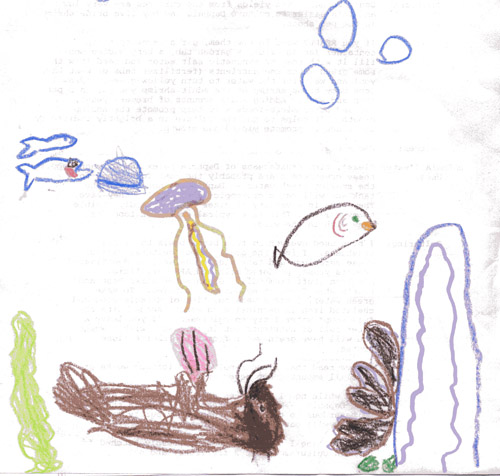
Younger offspring: I drew this picture of what we saw at the Monterey Bay Aquarium with Duke and Super Sally last weekend.
Dr. Free-Ride: Cool! I guess you really were paying attention to the exhibits when I thought you were just running around.
Younger offspring: (rolling eyes) Of course I was paying attention! So, when you scan this in, put labels on it.
Dr. Free-Ride: I think everyone will be able to tell what’s what.
Younger offspring: (sternly) Put labels on it. Some parts need labels to tell.
Dr. Free-Ride: OK.

The anchovy with the redness at the gills is swimming, mouth wide open, to feed. And, I’ll allow as how the crocodile tracks and the crocodile cave probably do benefit from being labeled.
Any predictions about who’s still in this ecosystem 24 hours later? Detailed explanations of your answers should be posted in the comments.

I believe that you mislabled the lobster ( http://www.areasofmyexpertise.com/lobsters.html ) as an otter.
The kelp, the mussels, the crocodile, and the jellyfish. Unless the crocodile has eaten recently (I recall that they can go a long time between feedings), in which case, the otter has a chance for at least 24 hours. But this seems to be a very unnatural ecosystem, as I can’t think of any overlapping crocodile and otter habitats.
You know, younger offspring was right. The labels help.
I’d probably get through the mussels, the anchovies, the kelp and the fish provided the fish is one of those mouth watering tuna from the big tank. I’m not a huge fan of alligator and I can only guess croc is similar.